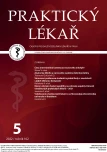Clean intermittent catheterization of the urinary bladder
Authors:
V. Šámal 1,2; V. Paldus 2; J. Špaček 1; M. Broďák 1
Authors‘ workplace:
Urologická klinika LF UK a FN, Hradec Králové, Přednosta: prof. MUDr. Miloš Broďák, Ph. D.
1; Urologické oddělení, Krajská nemocnice Liberec, a. s., Primář: MUDr. Jan Mečl
2
Published in:
Prakt. Lék. 2022; 102(5): 223-227
Category:
Reviews
Overview
Clean intermittent catheterization (CIC) is currently the method for patients who cannot urinate spontaneously or void incompletely. In these cases, the patient repeatedly inserts a urinary catheter to empty the bladder. In the home environment, he uses a sterile catheter for this in the conditions of community hygiene. The CIC method is widely used in the treatment of neurogenic dysfunctions of lower urinary tract, but its use is expanding also in non-neurogenic voiding dysfunctions. Complications include urinary tract infection and urethral injury. Compared to long-term catheterization with a permanent urinary catheter, these complications are significantly lower. The aim of the paper is to summarize the current information on clean intermittent catheterization of the bladder and encourages wider use of this method.
Keywords:
urinary tract infection – clean intermittent catheterization – dysfunction of lower urinary tract
Sources
1. Wyndaele JJ, Brauner A, Geerlings SE, et al. Clean intermittent catheterization and urinary tract infection: review and guide for future research. BJU Int 2012; 110(11 Pt C): E910–917.
2. Wyndaele JJ. Complications of intermittent catheterization: their prevention and treatment. Spinal Cord 2002; 40(10): 536–541.
3. Fowler CJ, Griffiths D, de Groat WC. The neural control of micturition. Nat Rev Neurosci 2008; 9(6): 453–466.
4. Weld KJ, Graney MJ, Dmochowski RR. Clinical significance of detrusor sphincter dyssynergia type in patients with post-traumatic spinal cord injury. Urology 2000; 56(4): 565–568.
5. Weld KJ, Graney MJ, Dmochowski RR. Differences in bladder compliance with time and associations of bladder management with compliance in spinal cord injured patients. J Urol 2000; 163(4): 1228–1233.
6. Guttmann L, Frankel H. The value of intermittent catheterisation in the early management of traumatic paraplegia and tetraplegia. Paraplegia 1966; 4(2): 63–84.
7. Lapides J, Diokno AC, Silber SJ, Lowe BS. Clean, intermittent self-catheterization in the treatment of urinary tract disease. J Urol 1972; 107(3): 458–461
. 8. Hanuš T. Intermitentni katetrizace močového měchýře. Čas. Lék. čes. 1983; 122(37): 1135–1137.
9. Krhut J, Zachoval R, Ženíšek J, a kol. Intermitentní katetrizace močového měchýře – indikace, technika, komplikace. Čas. Lék. čes. 2005; 144(10): 674–677.
10. Barber DB, Woodard FL, Rogers SJ, Able AC. The efficacy of nursing education as an intervention in the treatment of recurrent urinary tract infections in individuals with spinal cord injury. SCI Nurs 1999; 16(2): 54–56.
11. Yavuzer G, Gök H, Tuncer S, et al. Compliance with bladder management in spinal cord injury patients. Spinal Cord 2000; 38(12): 762–765.
12. Hooton TM, Bradley SF, Cardenas DD, et al. Diagnosis, prevention, and treatment of catheter-associated urinary tract infection in adults: 2009 International Clinical Practice Guidelines from the Infectious Diseases Society of America. Clin Infect Dis 2010; 50(5): 625–663.
13. Cardenas DD, Hooton TM. Urinary tract infection in persons with spinal cord injury. Arch Phys Med Rehabil 1995; 76(3): 272–280.
14. Dow G, Rao P, Harding G, et al. A prospective, randomized trial of 3 or 14 days of ciprofloxacin treatment for acute urinary tract infection in patients with spinal cord injury. Clin Infect Dis 2004; 39(5): 658–664.
15. Webb RJ, Lawson AL, Neal DE. Clean intermittent self-catheterisation in 172 adults. Br J Urol 1990; 65(1): 20–23.
16. Di Benedetto, P. Clean intermittent self-catheterization in neuro- urology. Eur J Phys Rehabil Med 2011; 47(4): 651–659.
17. Perrouin-Verbe B, Labat JJ, Richard I, et al. Clean intermittent catheterisation from the acute period in spinal cord injury patients. Long term evaluation of urethral and genital tolerance. Paraplegia 1995; 33(11): 619–624.
18. Mandal AK, Vaidyanathan S. Management of urethral stricture in patients practising clean intermittent catheterization. Int Urol Nephrol 1993; 25(4): 395–399.
19. Cardenas DD, Moore KN, Dannels-McClure A, et al. Intermittent catheterization with a hydrophilic-coated catheter delays urinary tract infections in acute spinal cord injury: a prospective, randomized, multicenter trial. PM R 2011; 3(5): 408–417.
20. Cardenas DD, Hoffman JM. Hydrophilic catheters versus noncoated catheters for reducing the incidence of urinary tract infections: a randomized controlled trial. Arch Phys Med Rehabil 2009; 90(10): 1668–1671.
21. Chartier-Kastler E, Denys P. Intermittent catheterization with hydrophilic catheters as a treatment of chronic neurogenic urinary retention. Neurourol Urodyn 2011; 30(1): 21–31.
Labels
General practitioner for children and adolescents General practitioner for adultsArticle was published in
General Practitioner

2022 Issue 5
Most read in this issue
- Anatomy of the venous and nervous system of the lower limb
- Clean intermittent catheterization of the urinary bladder
- Eating preferences of university students in connection with their body composition
- Education of General Practicioners at Slovak Medical University in Bratislava
